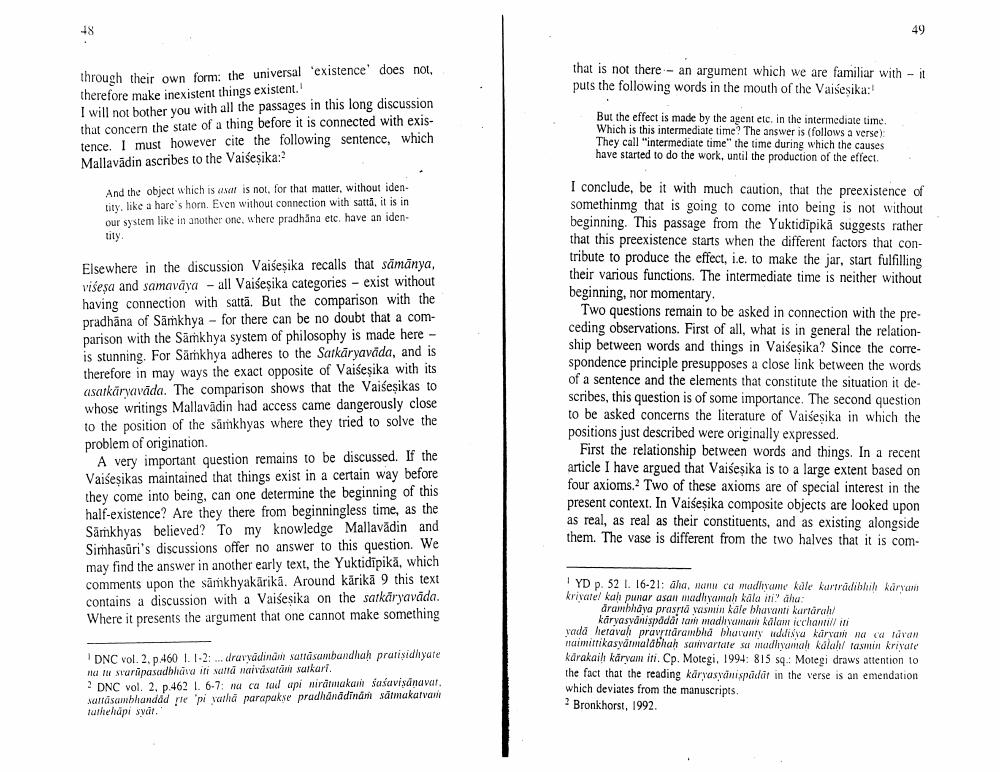________________
48
through their own form: the universal 'existence does not, therefore make inexistent things existent.
I will not bother you with all the passages in this long discussion that concern the state of a thing before it is connected with existence. I must however cite the following sentence, which Mallavädin ascribes to the Vaisesika:?
And the object which is asar is not, for that matter, without identity, like a hare's horn. Even without connection with satta, it is in our system like in another one, where pradhana etc. have an iden
tity.
Elsewhere in the discussion Vaiseșika recalls that sämanya, viseșa and samavaya - all Vaiseșika categories - exist without having connection with satta. But the comparison with the pradhana of Samkhya for there can be no doubt that a comparison with the Samkhya system of philosophy is made here -- is stunning. For Sämkhya adheres to the Satkāryavada, and is therefore in may ways the exact opposite of Vaiśeşika with its asatkaryavāda. The comparison shows that the Vaiseṣikas to whose writings Mallavädin had access came dangerously close to the position of the sämkhyas where they tried to solve the problem of origination.
A very important question remains to be discussed. If the Vaiseṣikas maintained that things exist in a certain way before they come into being, can one determine the beginning of this half-existence? Are they there from beginningless time, as the Sämkhyas believed? To my knowledge Mallavädin and Simhasüri's discussions offer no answer to this question. We may find the answer in another early text, the Yuktidīpikä, which comments upon the samkhyakärikā. Around kärikā 9 this text contains a discussion with a Vaiśesika on the satkaryavāda. Where it presents the argument that one cannot make something
DNC vol. 2, p.460 1. 1-2: dravyādinām sattasambandhaḥ pratișidhyate na tu svarupasadbhava iti satta naiväsatām satkarī
2 DNC vol. 2, p.462 L 6-7: na ca tad api niratmakam sasaviṣaṇavat. sattasambhandad rte 'pi yatha parapakṣe pradhānādinām satmakarvan tuthehapi syat."
49
that is not there an argument which we are familiar with it puts the following words in the mouth of the Vaisesika:
But the effect is made by the agent etc. in the intermediate time. Which is this intermediate time? The answer is (follows a verse): They call "intermediate time" the time during which the causes have started to do the work, until the production of the effect.
I conclude, be it with much caution, that the preexistence of somethinmg that is going to come into being is not without beginning. This passage from the Yuktidipikā suggests rather that this preexistence starts when the different factors that contribute to produce the effect, i.e. to make the jar, start fulfilling their various functions. The intermediate time is neither without beginning, nor momentary.
Two questions remain to be asked in connection with the preceding observations. First of all, what is in general the relationship between words and things in Vaiseșika? Since the correspondence principle presupposes a close link between the words of a sentence and the elements that constitute the situation it describes, this question is of some importance. The second question to be asked concerns the literature of Vaiseṣika in which the positions just described were originally expressed.
First the relationship between words and things. In a recent article I have argued that Vaiseșika is to a large extent based on four axioms. Two of these axioms are of special interest in the present context. In Vaiśeșika composite objects are looked upon as real, as real as their constituents, and as existing alongside them. The vase is different from the two halves that it is com
YD p. 52 1. 16-21: aha, nanu ca madhyame kale kurträdibhiḥ karyam krivatel kah punar asan madhyamah kala iti" aha:
arambhaya prasṛta yasmin kale bhavanti kartärah karyasyänispädäi tam madhyamam kalam icchamill iti yada hetavah pravṛttarambha bhavanty uddisya karyam na ca tavan naimittikasyamalabhaḥ samvartate sa madhyamah kalah tasmin kriyate kärakaiḥ käryam iti. Cp. Motegi, 1994: 815 sq: Motegi draws attention to the fact that the reading käryasyänispädät in the verse is an emendation which deviates from the manuscripts.
2 Bronkhorst, 1992.




